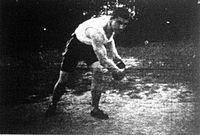1908 Summer Olympics / Athletics - Discus throw free style (men)

|
|
| sport | athletics |
| discipline | Discus throw (free style) |
| gender | Men |
| place | White City Stadium |
| Attendees | 42 athletes from 11 countries |
| Competition phase | July 16, 1908 |
| Medalist | |
|---|---|
|
|
Martin Sheridan ( USA )
|
|
|
Merritt Giffin ( USA )
|
|
|
Bill Horr ( USA )
|
The men's free style discus throw at the 1908 London Olympics was decided on July 16, 1908 at the White City Stadium . On the morning of the same day a qualification took place, from which three athletes qualified for the competition.
This is the form of this discipline that is still common today. It was thrown from a circle 2.50 meters in diameter. The throwing technique with up to three turns corresponded to today's common discus throw. At the Games in London, the so-called Greek style discus throw was also on the Olympic program.
There was a triple US success. Martin Sheridan won the gold medal, silver went to Merritt Giffin and bronze to Bill Horr .
Records
The world records were still unofficial back then. With regard to the Olympic record , the question arises whether the Athens interludes should be included or not. Both variants are taken into account in the table below.
| World record | 42.645 m |
|
Arthur Dearborn | 1908 |
| Olympic record - counting without interludes | 39.28 m |
|
Martin Sheridan | St. Louis Finale ( USA ), September 3, 1904 |
|
|
Ralph Rose | |||
| Olympic record - counting with interludes | 41.46 m |
|
Martin Sheridan | Athens Final ( Greece ), April 25, 1906 |
Taking into account that the results of the Athens Intermediate Games are not counted, the following records were improved or set in this discipline at the 1908 Olympic Games:
| OR | 40.70 m |
|
Merritt Giffin | qualification |
| 40.89 m |
|
Martin Sheridan | final |
Results
qualification
The qualification was held in six staggered groups. The results of these groups were combined. Only the best three participants in the qualification - highlighted in green - were able to contest the final competition. However, the performance achieved in the qualification was taken into account in the evaluation of the final result. In both the qualification and the final, the participants had three attempts each.
Group A
| athlete | country | Width (m) |
|---|---|---|
| Wilbur Burroughs |
|
37.43 |
| Platt Adams |
|
k. A. |
| Charles Lagarde |
|
|
| Ernest May |
|
|
| Henry Leeke |
|
|
| Walter Henderson |
|
|
| Alfred Flaxman |
|
|
| Ferenc Jesina |
|
Group B
| athlete | country | Width (m) |
|---|---|---|
| Arthur Dearborn |
|
38.52 |
| György Luntzer |
|
38.34 |
| John Flanagan |
|
37.80 |
| Mór Kóczán |
|
k. A. |
| Lauri Pihkala |
|
|
| Aarne Salovaara |
|
Group C
| athlete | country | Width (m) |
|---|---|---|
| Merritt Giffin |
|
40.70 OR |
| Michael Collins |
|
k. A. |
| Lauri Wilskman |
|
|
| John Garrels |
|
|
| Hugo Wieslander |
|
|
| Miroslav Šustera |
|
The above-mentioned Olympic record is only valid if one does not include the victory distance of 41.46 m achieved by Sheridan in the 1906 interludes.
Group D
| athlete | country | Width (m) |
|---|---|---|
| Bill Horr |
|
39.44 |
| André Tison |
|
38.30 |
| John Murray |
|
k. A. |
| Simon Gillis |
|
|
| Theodor Neijström |
|
|
| František Souček |
|
|
| Nikolaos Georgandas |
|
Group E
| athlete | country | Width (m) |
|---|---|---|
| Imre Mudin |
|
k. A. |
| Jalmari Sauli |
|
|
| Elmer Niklander |
|
|
| Folke Fleetwood |
|
|
| Ludwig Uettwiller |
|
Group F.
| athlete | country | Width (m) |
|---|---|---|
| Martin Sheridan |
|
40.58 |
| Verner Järvinen |
|
39.42 |
| Lee Talbott |
|
38.40 |
| Emil Welz |
|
37.02 |
| Edward Barrett |
|
k. A. |
| Otto Nilsson |
|
|
| Eric Lemming |
|
|
| Michalis Dorizas |
|
|
| Umberto Avattaneo |
|
|
| John Falchenberg |
|
Final and final result of the best team
| space | athlete | country | Width (m) |
|---|---|---|---|
| 1 | Martin Sheridan |
|
40.89 OR |
| 2 | Merritt Giffin |
|
40.70 |
| 3 | Bill Horr |
|
39.45 |
| 4th | Verner Järvinen |
|
39.42 |
| 5 | Arthur Dearborn |
|
38.52 |
| 6th | Lee Talbott |
|
38.40 |
| 7th | György Luntzer |
|
38.34 |
| 8th | André Tison |
|
38.30 |
| 9 | John Flanagan |
|
37.80 |
| 10 | Wilbur Burroughs |
|
37.43 |
| 11 | Emil Welz |
|
37.02 |
After the preliminary battle, Merritt Giffin led the field with his 40.70 m. But in the final, Martin Sheridan, who was thirteen centimeters behind him, outdid him with 40.89 m and thus repeated his Olympic victory in 1904 . Sheridan also won the competition at the Athens Intermediate Games in 1906 . Two days later, he won a third gold medal in the so-called Greek style discus throw, which is a one-time feature on the Olympic program. Bronze went to the fifth shot put by Marquis Bill Horr, who also won silver in the Greek-style discus throw. The Finnish winner of the Greek style throwing from the interludes Verner Järvinen took fourth place and two days later he was third behind Horr in the Greek style throwing. The current American world record holder Arthur Dearborn came in fifth .
As in the shot put, numerous athletes who were successful in discus or other disciplines did not make it into the top eight. Among them were the American Olympic champion in the standing vault of 1912 Platt Adams, the Greek Olympic third in the discus throw of 1904 Nikolaos Georgandas, the Swedish Olympic champion in the javelin throw of 1908 and 1912 Eric Lemming, the Swedish Olympic champion in the decathlon of 1912 Hugo Wieslander, the Finnish Olympic runner-up in the two-armed discus throw from 1912 Elmer Niklander and other athletes.
The above-mentioned Olympic record is only valid if one does not include the victory distance of 41.46 m achieved by Sheridan in the 1906 interludes.
In the sources there are some minor and two major deviations from the names and numbers listed above.
- Lee Talbot - In contrast to the information provided by Sports-Reference and Kluge , this is to be found at zur Megede among the throwers without a range specification, which means that all those placed behind are positioned one rank better at zur Megede .
- John Flanagan - as Talbot is listed in zur Megede under the throwers without indication of the distance, that means all those placed behind would be placed one position better with this author than with Sports-Reference and Kluge
- Marquis Bill Horr - Width indicated by Kluge by one centimeter less than the value mentioned above in Sports-Reference and for Megede
- Verner Järvinen - width indicated in zur Megede by one centimeter better than the value mentioned above in Sports-Reference and Kluge
- Emil Welz - width indicated in zur Megede by one centimeter less than the value mentioned above in Sports-Reference and Kluge
Double Olympic champion from 1908 Martin Sheridan, USA, also gold medalist in the discus throw from 1904 and from the interludes in 1906
The Olympic third Marquis Bill Horr, also Olympic runner-up in the discus throw, Greek style, and fifth in the shot put - here in 1907
World record holder Arthur Dearborn - here as a shot putter - had to be content with fifth place
The American Lee Talbot - here at the hammer throw - was Olympic champion
John Flanagan, USA - here in his special discipline hammer throw , in which he was three-time Olympic champion from 1900 to 1908 - came in ninth
The Swede Eric Lemming, clearly more successful as a javelin thrower , was eliminated in the qualification
There was also no final for the Swedish decathlon Olympic champion from 1912 Hugo Wieslander
literature
- Volker Kluge , Olympic Summer Games - The Chronicle I, Berlin 1997 ( ISBN 3-328-00715-6 )
- Ekkehard zur Megede , The history of Olympic athletics, Volume 1: 1896–1936, Verlag Bartels & Wernitz KG, Berlin, 2nd edition 1970
Web links
- Sports-Reference, Athletics at the 1908 London Summer Games: Men's Discus Throw , accessed August 31, 2018
- Olympic Games London 1908, Athletics , IOC page on athletics at the 1908 Olympic Games at olympic.org, English, accessed 31 August 2018

















